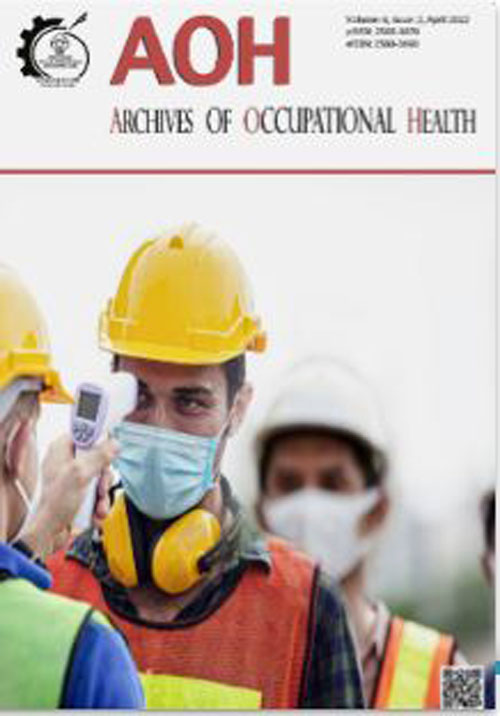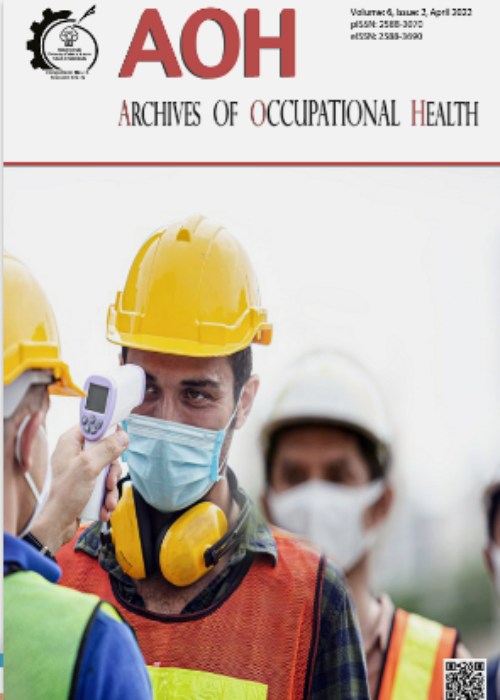فهرست مطالب

Archives Of Occupational Health
Volume:6 Issue: 2, Apr 2022
- تاریخ انتشار: 1401/04/12
- تعداد عناوین: 8
-
Pages 1209-1210
-
Pages 1211-1217Introduction
Coronavirus is a viral disease with fast spreading rate. It has become a pandemic and afflicted all countries. One of the ways to prevent the COVID-19 infection is to motivate public participation and to respect for health protocols. The level of adherence to the protocols depends on one’s risk perception. To measure the level of risk perception, a valid and reliable measurement tool is needed.
ObjectiveThe present study is an attempt to Psychometric Properties of Coronavirus infection risk perception Questionnaire with a working life approach.
MethodologyThe article concentrated on the generation, translation, cross-cultural adaptation, and psychometric risk perception questionnaire. In this cross-sectional study, we generated an item pool extracted from the literature relating to risk perception in COVID-19 disease. A sample of 228 participated in the study. The initial scale consisted 41 Items were produced from literature. A scale containing 26 Items appeared as a result of an exploratory factor analysis. Cronbach’s alpha was used to measure the internal consistency. Data analysis was conducted at 95% confidence level. The data analyzed using the SPSS statistical version (V. 21).
FindingsExploratory factor analysis of the scale explained 45.3% of the variance observed. In addition to analyses indicated satisfactory results for internal consistency (Cronbach's alpha ranging from 0.76 to 0.84) and intra-class correlation (ranging from 0.79 to 0.94).
ConclusionThis study generated the Persian-language version of the coronavirus infection risk perception in Iranian individuals through psychometric testing to measure risk perception. Based on the results of this study, this questionnaire is reliable for measuring people's risk perception.
Keywords: Psychometric, pandemic, Risk Perception, COVID-19 -
Pages 1218-1223Introduction
The outbreak of coronavirus is a global crisis that has greatly affected the daily activities of individuals and has caused many deaths and injuries in the world. Because observing the preventive behaviors of the general public is one of the main ways to break the chain of transmission of the disease and get rid of this crisis. The aim of this study was to determine the extent of prevention of coronavirus disease in lifestyle and home-based jobs in Iranian society.
Materials and MethodsIn this validation and methodological study, after reviewing the opinions of experts, basic and effective questions were collected to evaluate the extent of preventive behaviors against coronavirus. Formal and content validity in quantitative and qualitative methods were used to validate the instrument. Cronbach's alpha coefficient was used to evaluate the internal reliability of the instrument. Questions with a face validity index greater than 1.5, a CVI index greater than 0.79, and a CVR index greater than 0.62 were considered appropriate. If Cronbach's alpha coefficient is greater than 0.7, the internal reliability of the instrument is established.
ResultsThe face validity of all questions was more than 1.5 and the face validity of all questions was confirmed. The value of the CVI index in the 5 questions of the questionnaire was less than 0.79. Also, the value of the CVR index in the same 5 questions was less than 0.62. After removing the above 5 questions, the final questionnaire of 16 questions was introduced as a tool. Also, the internal reliability of the instrument was (α = 0.71).
ConclusionThe results of this study showed that the proposed questionnaire is suitable for measuring the level of preventive behaviors against coronavirus in lifestyle and home-based businesses and has good validity and reliability as a useable tool.
Keywords: Coronavirus, preventive behaviors, lifestyle, home-based jobs -
Pages 1224-1229Background
Due to the Covid-19 pandemic and the increase in anxiety in the community, this study aims to investigate the relationship between anxiety symptoms and demographic characteristics of administrative staff during the Covid-19 pandemic.
MethodsWe selected 193 Administrative staff in Qazvin to participate in a cross-sectional descriptive study, using a multi-stage sampling method. Data collection tools included a demographic information questionnaire and the Corona Disease Anxiety Scale (CDAS). Data were analyzed using SPSS software, independent t-test, ANOVA, and Pearson correlation coefficient. The significance level was considered to be 0.05.
ResultsThe mean age of participants was 33.61±8.3. 62.6% were female and 75.2% were married. Anxiety score with a mean and standard deviation of 24.88±7.52 was evaluated to be moderate. There was a significant positive correlation between anxiety score and age (P= 0.007 and r= 0.267), and work experience (P= 0.003 and r= 0.313). Participants with a family member over the age of 65, or a member with a chronic illness, had significantly higher mean anxiety scores than other participants.
ConclusionEmployees' anxiety in this study was assessed as moderate. To bring anxiety to a low level and increase the general health of individuals, it is suggested that managers and heads of departments consider programs to reduce the anxiety of employees. By reducing anxiety scores, they can increase the productivity of these people.
Keywords: Anxiety, Demographic, Covid-19, Employee, Pandemics -
Pages 1230-1235Background
Migrant workers are at a high risk of exposure to COVID-19 due to their work and residential status. Surveillance for SARS-COV-2 in this group is important for early detection of infection and breaking the chain of disease transmission in the workplace and community. This report describes an enhanced active surveillance strategy for COVID-19 in migrant workers of Brunei Darussalam during the first wave of the outbreak in 2020.
MethodsActive and phased surveillance of migrant workers for SARS-CoV-2 was conducted by the Ministry of Health on a total of 9443 workers, in 2020. Surveillance was carried out using a nasopharyngeal swab test for SARS-CoV-2 reverse transcription-polymerase chain reaction (RT PCR) in phases I and II, whilst a rapid antigen test was used in phase III.
ResultsPhase I included 7073 workers from 714 workplaces; phase II covered 860 workers from 190 workplaces; and phase III covered 1510 workers. Three positive cases were detected during phase I of the surveillance. No migrant worker was tested positive for SARS-CoV-2 during the second and third phases of surveillance.
ConclusionThe number of positive cases detected was small; however, this strategy actively searched for the presence of SARS-CoV-2 among the migrant worker population in the country, and further confirmed the absence of any hidden local transmission of cases in this population.
Keywords: Migrant worker, COVID-19, surveillance, screening -
Pages 1236-1242Background
Due to the prevalence of the Covid-19 virus and its effects on people's lives and the lack of studies on non-health workers, the present study was conducted to evaluate Covid-19 anxiety and its relationship with sleep quality among industrial workers.
MethodsThe research method was descriptive and cross-sectional. We selected 212 individuals using random sampling. Data were collected using a demographic information questionnaire, the Corona Disease Anxiety Scale (CDAS), and the Pittsburgh Sleep Quality Index (PSQI). For data analysis, Pearson correlation test, independent t-test, and ANOVA were used in SPSS software version 24.
ResultsThe mean age of participants was 33.27±6.6, 78.8% of whom were male, and 79.3% were married. The CDAS and PSQI score's mean and standard deviation were 11.60±8.2 and 5.37±1.7, respectively. There was a significant relationship between CDAS scores and age (P= 0.008) and work experience (P= 0.005). Also, a significant relationship was observed between PSQI score and age (P= 0.032) and work experience (P= 0.009). There was a significant correlation between CDAS and PSQI scores (r= 0.341 and P= 0.007). People with lower levels of education showed high anxiety scores and poor sleep quality.
ConclusionAccording to the findings of this study, the authors concluded that by reducing anxiety, the quality of sleep could be increased. Therefore, to reduce anxiety and increase the quality of sleep and employee productivity, the researchers suggest that factory managers identify and eliminate the causes of anxiety by establishing continuous and regular mental health training.
Keywords: Anxiety, Covid-19, Sleep Quality, Workplace -
Pages 1243-1249Background
The spread of coronavirus (Covid-19) had many psychological consequences. Nurses experience anxiety due to their professional duties. Considering the importance of mental health and caring behaviors in nurses, the present study was conducted to investigate Covid-19 anxiety in nurses and its relationship with cognitive flexibility.
MethodThe present study was conducted on 100 nurses of a selected hospital in 2021. Data collection tools included demographic questionnaire, Corona Disease Anxiety Scale (CDAS) and Cognitive Flexibility Inventory (CFI). Data analysis was performed through version 22 of SPSS software using Mann-Whitney, Kruskal–Wallis, independent sample t-test, one-way ANOVA and correlation tests.
ResultsThe mean of cognitive flexibility was 96.68 (13.72). The median of Covid-19 disease anxiety was equal to 8 (9). Accordingly, the results of data analysis showed that there was no significant relationship between demographic variables and covid-19 anxiety (P>0.05). Furthermore, no significant relationship was found between cognitive flexibility and covid-19 anxiety (P>0.05).
ConclusionIn this study, cognitive flexibility had no significant effect on Coronavirus disease anxiety. Considering the presentation of contradictory results in this field, authors suggest that a similar study be conducted with a larger sample size and different variables be taken into account.
Keywords: Cognitive Flexibility, Anxiety, Covid-19, Nurses


